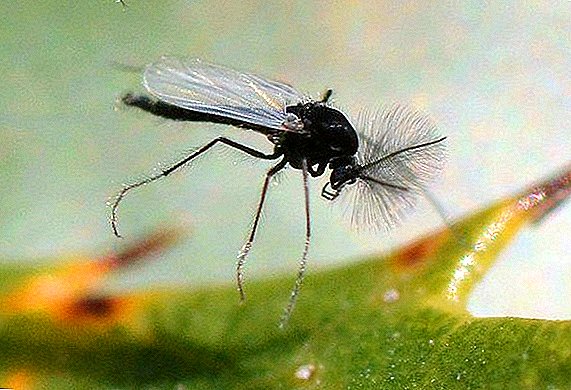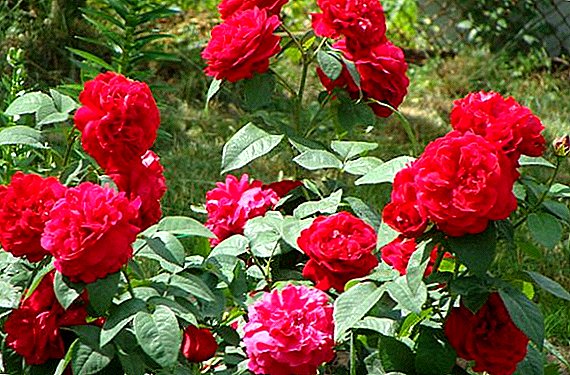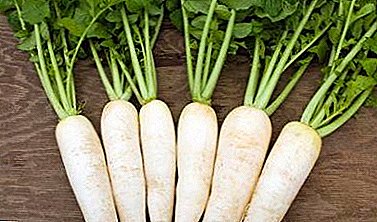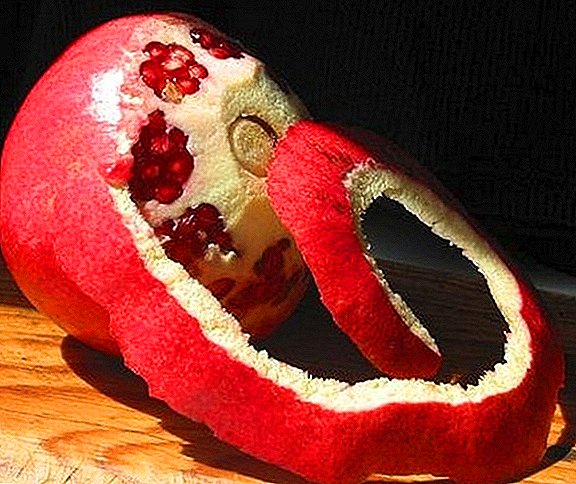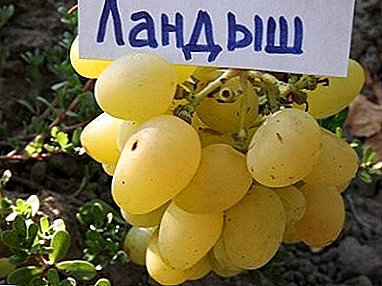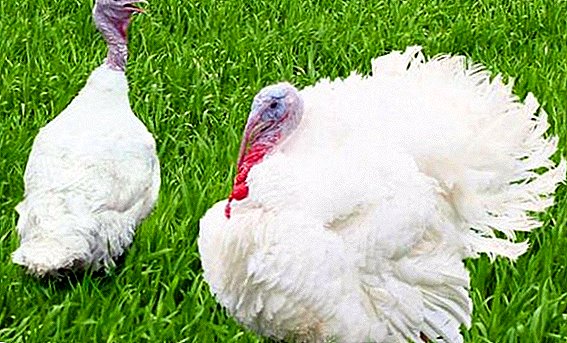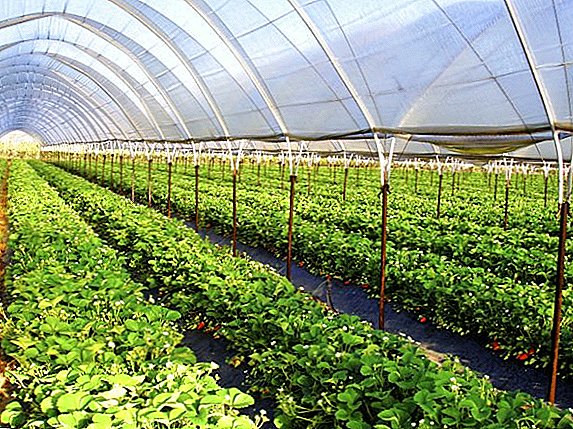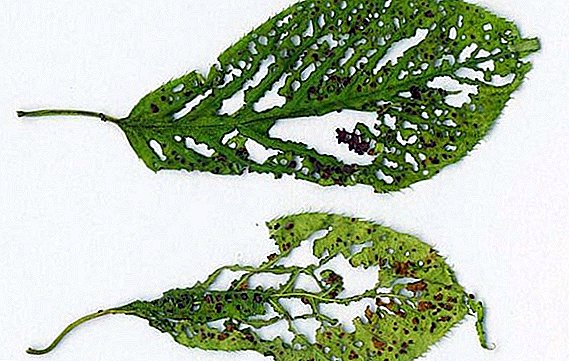 In modern conditions, gardeners are faced with many difficulties, one of which is severe fungal infection of fruit plants. One of them include the disease of cholesterol. The disease is quite common in almost all climatic zones and every year captures an increasing number of suburban areas. However, not everyone knows how to properly deal with manifestations of phytosteriasis, which directly affects the yield and quality of crops of fruit crops. Therefore, today we will examine in detail what this plant disease is, and also identify the main ways to effectively combat it.
In modern conditions, gardeners are faced with many difficulties, one of which is severe fungal infection of fruit plants. One of them include the disease of cholesterol. The disease is quite common in almost all climatic zones and every year captures an increasing number of suburban areas. However, not everyone knows how to properly deal with manifestations of phytosteriasis, which directly affects the yield and quality of crops of fruit crops. Therefore, today we will examine in detail what this plant disease is, and also identify the main ways to effectively combat it.
Causative agent
 The main cause of the manifestation of phytosteriasis is a microorganism. Clasterosporium carpophilumwhich belongs to the family Magnaporthaceae. It is a microscopic parasitizing imperfect fungus, the habitat of which is the tissues of higher trees, mainly fruit species. The life cycle of a microorganism provides for the conidial stage of development.
The main cause of the manifestation of phytosteriasis is a microorganism. Clasterosporium carpophilumwhich belongs to the family Magnaporthaceae. It is a microscopic parasitizing imperfect fungus, the habitat of which is the tissues of higher trees, mainly fruit species. The life cycle of a microorganism provides for the conidial stage of development.
Often the conidia are short, without partitions, sometimes elongated, sometimes rounded, but often also club-shaped. In young individuals, they are almost colorless, with age they acquire light brown or yellowish-olive shades. The optimal temperature for the development of the fungus - average daily +20 ° C, therefore the season cluster is activated twice in spring and autumn.
Did you know? In ancient Greece, spotting, rot and other diseases of agricultural plants were fought with the help of fumigation with sulfur fumes.
The initial infection occurs in early spring, after the occurrence of a constant average daily temperature of about + 4 ... +5 ° С. During this period, the plant's immunity is weakened; therefore, last year’s generation of the myopia of the klyasterosporium easily strikes cracks or wounds on the trunk and branches of trees. After this, its active reproduction and spore production occurs.  With sufficient humidity and average daily temperature of about + 20 ° C, spores of the fungus germinate. This process occurs fairly quickly (in just 19–20 hours), however, the first signs of kleasterosporiosis are observed only after 5–6 days. Disputes are resistant to various atmospheric manifestations, so their viability can persist for years. For the entire warm period of the year, the causative agent succeeds in creating 2 full generation spores.
With sufficient humidity and average daily temperature of about + 20 ° C, spores of the fungus germinate. This process occurs fairly quickly (in just 19–20 hours), however, the first signs of kleasterosporiosis are observed only after 5–6 days. Disputes are resistant to various atmospheric manifestations, so their viability can persist for years. For the entire warm period of the year, the causative agent succeeds in creating 2 full generation spores.
The wintering of Clasterosporium carpophilum occurs on the surface of wood in the form of mycelium and conidiospores in gums, and the fungus is also preserved in plant litter. The period of its rest in this case can last several years. The spread of the pathogen occurs in several ways. Insects, birds and animals that carry spores on the surface of their bodies can become its distributors. It also actively spreads to neighboring areas with the help of rain, wind, infected leaves and other parts of the plant.
Find out how trees can get sick.
What is striking and how it manifests itself
Often, trees with stone fruit suffer from klyasterosporia. Mostly it is apricot, cherry, plum, peach and sweet cherry. The microorganism affects almost all areas and aboveground organs of fruit plants, so the fungus develops on the buds, leaves, flowers, ovaries, fruits, and even lignified shoots.  However, the characteristic symptom of phytosteriasis is an active lesion of the leaves of the trees. As a consequence, they appear spots of red-brown or crimson shades with a diameter of 1-2 mm. A few days later, they increase by 2 times, to 4-5 mm, after which the fabric in this place gradually dies off. This leads to the fact that the affected areas of the sheet dry and crumble, and a through hole with a characteristic reddish rim appears in the sheet.
However, the characteristic symptom of phytosteriasis is an active lesion of the leaves of the trees. As a consequence, they appear spots of red-brown or crimson shades with a diameter of 1-2 mm. A few days later, they increase by 2 times, to 4-5 mm, after which the fabric in this place gradually dies off. This leads to the fact that the affected areas of the sheet dry and crumble, and a through hole with a characteristic reddish rim appears in the sheet.
Did you know? The first chemical agent to fight fungal diseases of fruit plants was invented by the French botanist Alexander Milliard in 1885. This so-called Bordeaux liquid, which to this day is often used by farmers and gardeners around the world.
With excessive active reproduction of the pathogen, shoots of fruit trees are also affected. Small rounded spots with a diameter of about 1 mm of red or orange hue, with a brown or black border, appear on their surface. After a few days, they increase to 3-5 mm, stretch out, press into the surface and eventually crack. At the same time, the color of the spot changes to a paler with a purple border around the contour. Not uncommon is the abundant selection of such gum sites - thick resinous substance. In the case of late treatment of an illness, the cracks heal, and growths form around them.
The affected buds of the tree are also covered with characteristic spots, after which they begin to liberate gum abundantly. Gum dries, and gradually their surface becomes glossy. Over time, the tissues turn black, and the kidneys die and crumble. If before this point they have time to develop flowers, the clusterosporiosis causes them to fall.  The klyasterosporium can develop on fruits - ulcerous spots appear on their surface. At the beginning of the process, they may have shades of brown-red or brown colors. Over time, they grow and take the form of warts. The top of the wart hardens, then falls off, and in its place a dimple forms, from which gum abundantly flows. Occasionally, the spots may grow together, forming a scab or scab, in which case the fruits die off completely.
The klyasterosporium can develop on fruits - ulcerous spots appear on their surface. At the beginning of the process, they may have shades of brown-red or brown colors. Over time, they grow and take the form of warts. The top of the wart hardens, then falls off, and in its place a dimple forms, from which gum abundantly flows. Occasionally, the spots may grow together, forming a scab or scab, in which case the fruits die off completely.
Read also about fighting scab on apples and pears.
Methods of struggle
In modern agronomy, there are many ways to combat the ailments of fruit trees, however, to eliminate the hole spotting, only two approaches are used: prevention of the disease by means of agrotechnical methods, as well as the elimination of the direct manifestations of the fungus with highly active chemicals. Consider each of these methods in more detail.
Agrotechnical events
Agrotechnical measures to prevent klyasterosporiosis are quite simple, so even a novice gardener will be able to cope with them without too much difficulty. The first thing to do before planting stone fruit trees is pay attention to disease-resistant varieties. In most cases, such species are not expensive, and their fruits are able to fully satisfy even the picky gardener.
If you have to take care of already planted trees, first of all, you need to carefully inspect the plant at least 2 times per season (spring and autumn). All affected areas must be removed with a garden pruner or other tools. Such parts of the plant are a real danger to your garden, so they need to be burned as soon as possible or taken out of the territory of the site.
After cutting, the sections must be protected, for this purpose they use healing disinfectants. The best option is a thick lime mortar with the addition of copper (1 g / liter) or iron sulphate (3 g / liter).
Important! All garden tools that have been in contact with the affected areas of the tree must be disinfected with 40% alcohol or 0.5% potassium permanganate solution. Otherwise, the inventory can become an active carrier of phytosteriasis.
Often, pruning of tree branches is carried out with a rejuvenating and aesthetic goal; this is a necessary measure, the observance of which helps not only to give the tree the desired look, but also to increase its fertility. However, it is this procedure in most cases that is the cause of the infection of the plant by the clasterosporium carpophilum fungus, since a fresh and moist wound is the ideal environment for its development.
Therefore, in order for pruning to not soon become the cause of the death of the entire crop, it is necessary to sanitize the cut of the shoots and protect them from possible infection. To do this, they are treated with a solution of copper sulfate (3 g / liter of water), and then cover with garden pitch. In addition, care should be taken about the treatment of wounds and cracks in the trunk and shoots, they are also treated with copper sulfate solution, and then smeared with garden pitch.
Familiarize yourself with the basics of pruning trees (rejuvenating) and the technology of preparing garden pitch.
It is important not to forget about elimination of leaf litter from the garden. Foliage is an ideal source of moisture and nutrients necessary for the klyasterosporium, it often becomes a place for the primary development of fungal spores. Therefore, in order to prevent the occurrence of this infection, fallen leaves at the end of the season must be collected and disposed of.
In addition, reducing the likelihood of perforated spotting will help and digging around a tree trunk to a depth of about 30 cm, it is necessary not to forget to eliminate all kinds of litter. To improve the efficiency of the procedure, the soil is eradicated by spraying with antiseptics in late autumn or spring, before bud break. To do this, the freshly dug soil is treated with 1% solution of DNOC or 3% solution of nitrafen to choose from.
Important! Pruning trees in wet or rainy weather should not be carried out. Spores of the klyasterosporium together with water droplets can get into fresh sections, which will only increase the infection of the tree.
Chemical spraying
For the purpose of direct treatment of fruit trees for phytosteriasis, spraying of the trunk and crown with highly active chemicals is used. For these purposes, in professional and amateur gardening they use various potent means, as well as processing schemes. All of them in one way or another have their advantages and disadvantages, but the most effective is a comprehensive protection of the garden. It consists in periodical treatment of plants throughout the entire period of active vegetation.
Be sure to process the trees need not less than 2 times per season, in the spring, before the leafing, and in the fall, during the period of massive leaf fall. To do this, use a 3% solution of copper sulfate or Bordeaux liquid. Prophylactic dressing is carried out during the active growing season of plants. Most often, trees in the garden are processed 1-2 weeks before or at the time of flowering, the second time - at the end or 2-3 weeks after this process.
We advise you to read about the treatment of diseases of garden plants: cherries, cherries, apples, pears, grapes, peaches, raspberries, apricots.
Most popular drugs for prophylactic treatment are as follows:
- "Captan" (50 g / 10 l of water): the solution is used after flowering and 10-12 days after the initial treatment;
- “Fast” (2 ml / 10 l of water): the mixture is used one week before active flowering and 2-3 weeks after the end of the process;
- "Signum" (1-1.25 kg / ha): the drug is used twice, during the beginning of flowering and 10-14 days after the first treatment;
- "Horus" (2.5-3 g / 10 l of water): a garden is treated with a fungicide a week before flowering and 2-3 weeks after it. The drug is used to combat the disease in the active phase. To do this, plants are treated 2 times with a frequency of 10-12 days;
- "Zineb" (40 g / 10 l of water): the drug is used after flowering and 10-12 days after the initial treatment.





Important! Work with fungicides should be carried out exclusively in personal protective equipment strictly following the rules for working with toxic substances.
Resistant varieties
The most effective and profitable way of preventing perforated spotting is cultivation of varieties of fruit trees resistant to this disease on its own site. Today there are a lot of varieties of such plants on the market, but not all of them are distinguished by high yield and quality of their fruits. Next, we consider the most fruitful and resistant to fungal infections varieties of stone fruit.
Apricot
Among the apricot, Clasterosporium carpophilum is resistant to the following varieties:
- "Pineapple" is a self-fertile variety, its active fruiting occurs already in 3-4 years after planting. Fruits are light yellow, with almost no blush. They have a universal purpose, so they are suitable for both raw food and for making jams, jams and other things;
- "Red-cheeked" - unpretentious high-yielding variety, its main highlight are the characteristic bright red spots on the fruit. Fruits are suitable for both raw consumption and for processing;
- Spitak is an old-Armenian samobzplodny variety, a typical representative of Iranian-Caucasian fruit plants. Apricot fruits have a rather light, almost white color. The variety has a large number of varieties and forms;
- "Shalah" - an early ripe universal grade. Fruits differ in noticeable size and juiciness, their color is mainly soft cream shades with pale crimson spots on the sides.



Read also about the fight against diseases of garden plants: moniliosis (cherry and cherry, apricot), rust.
Peach
The most resistant varieties of peaches to asteriasis are:
- Greensboro is a typical early Chinese variety in China. The fruits are large, strongly pubescent, greenish-cream shades. "Greensboro" is a universal grade, but completely unsuitable for packaging and long-term transportation;
- "Cardinal" is an early ripe variety, distinguished by juicy and fragrant fruits with an orange color and red patches. Its main feature is the almost perfect balance of fruit taste between sweetness and sourness;
- "Kiev early" is an early ripe peach variety, ideal for temperate climates. Its main highlight is the high winter hardiness, precocity and unpretentiousness in the care and growing conditions. The fruit color is bright orange with slight reddish patches;
- "Elbert" is a North American peach variety brought to Russia in the 19th century. The plant is characterized by large fruits of bright orange-yellow shades with high transportability. Peach is suitable for use both in raw and canned form.




Did you know? In China, the peach tree is a symbol of longevity and even immortality.
Cherries
Most often among the cherries you can find the following varieties of a plant, which are resistant to cloistersporium:
- "Amateur" - a high-yielding variety, characterized by medium or late ripening. Fruits are large, rich red in color, have a high aroma and taste, can be used in raw form or for the preparation of various products;
- "Lyubskaya" - a variety used for food and decorative purposes. Fruiting occurs within 2-3 years after planting. The berry is large, of red saturated shades, with tender sour-sweet pulp. Fruits are mainly grown for industrial purposes, but can also be found on private household plots;
- “Early dessert” is an ultraearly cherry variety characterized by large bright red fruits, juicy and tender flesh, as well as a sweet and sour taste. Fruits are transportable and perfectly preserved, have a universal purpose;
- "Sputnitsa" is a medium-growing, drought-resistant and winter-hardy variety, it starts fruiting within 3-4 years after planting. The fruit of the cherry juicy, fragrant, bright red, universal purpose.


Read also about the signs and treatment of coccomycosis trees.
Sweet cherries
The following varieties of sweet cherries can be called the most resistant to asteriasis:
- "Valery Chkalov" is a variety of early ripening with an average yield and high frost resistance. The berries have a bright red tint, as well as juicy flesh. Fruits can be used raw, but are best suited for preparing all kinds of canned foods;
- "Zodiac" - skoroplodny high-yielding variety, intended for cultivation in a subtropical climate. Fruits are large, heart-shaped, bright red with a soft and juicy flesh, are highly transportable;
- "Napoleon" - a high-yielding variety, characterized by a late ripening period. The plant is unpretentious to the habitat conditions, moisture and soil characteristics, therefore it can grow in almost any latitude with a temperate climate. Fruits are bright, saturated red. With proper care, the tree can bear fruit for 100 years;
- "Tenderness" is a self-productive high-yielding variety, characterized by large heart-shaped yellow berries and bright pink blush. The flesh is bright yellow, juicy, sweet-sour to the taste. Transportability of fruits is high, the purpose is universal.



Plums
Among plums, the following varieties have the greatest resistance to the causative agent of perforated spotting:
- "Anna Shpet" - a thermophilic variety, cultivated in the conditions of the southern climate.Fruits are large, dark purple or burgundy with a light frosted patina, juicy flesh, soft, yellow-green;
- "Hungarian Azhanskaya" - an early high-yielding variety, quite widespread in the southern regions of the CIS. Fruiting occurs early, already 4-5 years after planting. Fruits are medium in size, the peel of a brownish-red or purple hue is covered with a thin matte coating. The flesh is tender, juicy, greenish-yellow hue;
- "Green green" - one of the most ancient and common varieties of fruit plants. Optimal for habitat are regions with a subtropical climate, but the variety is also distinguished by high cold resistance (within the framework of a warm climate). Fruits of medium size, juicy, peel and flesh of green or greenish-yellow hue;
- "Kirke" - amateur high-yielding mid-season variety intended for cultivation in the southern regions. The plant is distinguished by large fruits of dark blue color with whitish bloom, juicy, tender, greenish-yellow flesh.


The disease, such as powdery mildew, affects many garden plants (roses, petunia, currants, grapes, apple trees, gooseberries), garden crops (tomatoes, cucumbers) and house crops (violet).
Video: measures for the control of phytosteriasis
Klesterosporiosis is a fairly dangerous fungal disease that most stone fruit is exposed to. This ailment is ubiquitous, it can be found in any climatic zones. Therefore, in order to prevent the development of perforated spot on their own summer cottage, first of all, it is necessary to cultivate varieties resistant to the ailment, as well as strictly observe agricultural techniques and principles of chemical protection of fruit trees.


